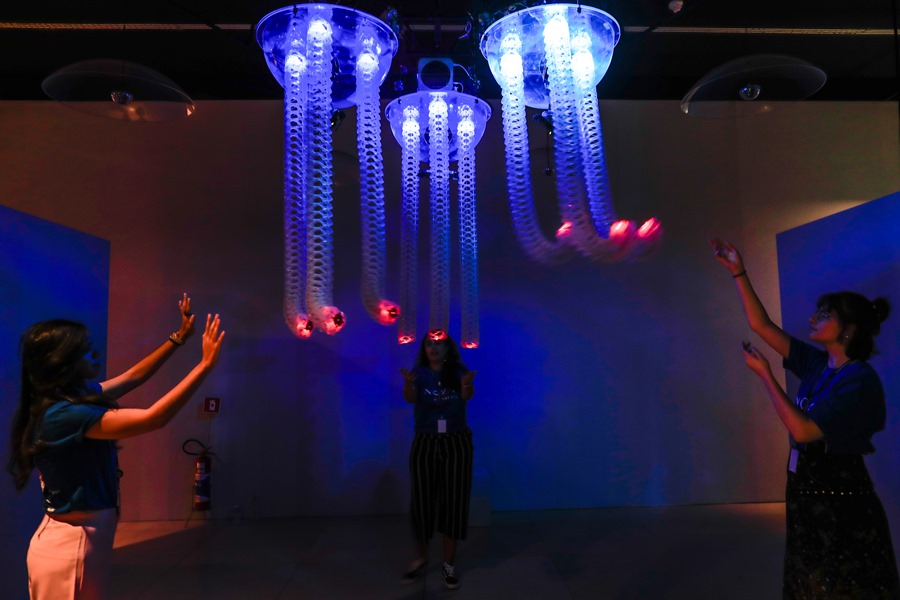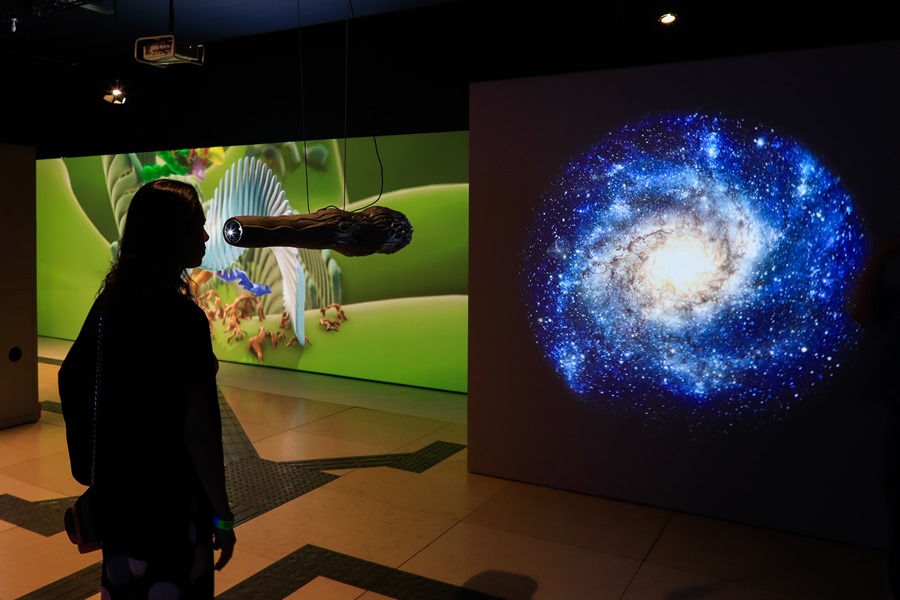
Rio de Janeiro opens the doors for art and technology
Rio de Janeiro opens the doors of its first international art and technology biennial
Rio de Janeiro, Sep 20 (EFE).- A contemporary international exhibition of artistic and interactive creations that make use of technology and innovation opens its doors starting this Wednesday in Rio de Janeiro, the most iconic city in Brazil.
In total, 70 works out of 66 by creators, including artists, groups or studios, from 30 countries are part of the Nova Rio Biennial of Art and Technology, an exhibition that seeks to reconfigure the idea of the future and invites active interaction with the public. .
This is the first edition of the event, for which the Museum of Tomorrow, designed by the Spanish Santiago Calatrava, located on the shores of the port of Rio, was chosen as the venue and setting.
The exhibition invites the public to experience art with augmented realities, works with artificial intelligence, animations, video games, interactive installations and virtual realities in which attendees will be able to touch, tour and even integrate into the works.
According to Ricardo Barreto and Paula Perissinoto, curators of the exhibition, the works are divided into two main themes: The new aesthetics and supercreativity in the era of artificial intelligence.
The magic of “interactive scientific art”

Three women interact with the work “Petting Zoo”, by the Minimaforms studio, which is part of the first edition of the Nova Rio Biennial of Art and Technology. EFE/Andre Coelho
In the first group, the game “The Great Adventure Of Material World” by Chinese author Lu Yang stands out, which uses cinematographic mechanisms with 3D animations and holograms, among other resources.
Also the work “Capture”, by the Finnish Hanna Haaslahti, which allows visitors to create their own digital avatar and interact with a virtual crowd.
Already in the projects created with artificial intelligence, “Liminal” stands out, by Canadian Louis-Philippe Rondeau, a work with an arc of light that tries to be a metaphor for a portal in time.
Works by the Venezuelan Camila Magrane, the Italian Francesca Fini, the Swede Anders Lind, the American Sam Rolfes and the Belgian Lef Spincemaille are part of the exhibition that will also have works from Japan, Serbia, Nigeria, France and Greece, among others.
That of the Colombian Leo Castañeda, creator of “Levels and Bosses”, fuses games, painting, virtual reality, drawing and sculpture in a work that provides another look at the progression structures, hierarchies and violence of many video games, but that also includes a message of environmental care.

A woman interacts with the work “Expanded iris”, by the artist Anaisa Franco, at the Museum of Tomorrow in Rio de Janeiro (Brazil). EFE/Andre Coelho
"One of the ideas of the game is that the energy system is revalued, so (the game) is not based on extraction, where one is destroying other beings or the environment to obtain energy, but rather it is a more mutualistic system, where the needs of the environment are heard,” he explained to EFE.
Other works, such as “Quantum Jungle”, by the German artist Robin Baumgarten, have a scientific nature.
The work, developed for the University of Finland, “represents all the states in which quantum particles can be,” the author told EFE.
Art, technology and innovation for everyone
Open until October 29, the New Rio Biennale of Art and Technology will also have some works exhibited for twelve days in the square in front of the museum, so that people can appreciate and interact with them for free.
Among these installations will be “Animaris ordis”, one of the wind-driven sculptures by the Dutch artist Teo Jansen, and the “Tube” structure, a kind of penetrable network, by the Numen/For Use Studio collective, which includes artists from Germany, Austria and Croatia.
70 works out of 66 by creators - including artists, groups or studios, from 30 countries - are part of the Nova Rio Biennial of Art and Technology
Likewise, the articulated polytope sculptures by the Brazilian artist Ludmila Rodrigues, with which the public will be able to create multiple compositions and experiment with space while molding a geometric shape.
“This exhibition will please audiences of the most diverse profiles. We are sure that children, young people, adults and the elderly will find here extremely relevant experiences that propose a reflection on the social transformations promoted by technologies," Amarilis Lage, exhibition and content coordinator of the Museum of Tomorrow, told EFE.

- April 14, 2025
Gallery of Illustration by Ananda Ferreira – Brazil


- April 14, 2025
Gallery of Illustration by Luis San Vicente – Mexico

- April 14, 2025
Art, Culture, and Technologies for Peace

- April 14, 2025
Cuartel del Arte Exhibits “Graphic Paths”


- April 14, 2025
Gallery Of Illustration By daria filippova - Ukraine

- April 14, 2025
Gallery Of Humor Drawing By Fahd Bahady - Syria


- April 14, 2025
Art, Culture, and Technologies for Peace

- April 14, 2025
Cuartel del Arte Exhibits “Graphic Path…

- April 13, 2025
Malba on the Way to 25 Years

- April 12, 2025
Exhibitions celebrate 65 years of Brasí…

- April 12, 2025
Weekend 2025 Prepares for Two Days of A…

- April 10, 2025
Luis Felipe Noé Dies at 91

- April 09, 2025
Buenos Aires Awakens to Art

- April 09, 2025
Rosario Latin American Film Festival

- April 09, 2025
Nahuel Vecino's Largest Exhibition

- April 08, 2025
Bogotá hosts the exhibition by artist J…

- April 07, 2025
Paris Latin American Film Festival Winn…

- April 06, 2025
"Capital Feria": The First Latin Americ…

- April 06, 2025
African and Latin American Art

- April 05, 2025
The first exhibition dedicated to a Lat…

- April 05, 2025
The first private art initiative outsid…

- March 30, 2025
The first Latin American Art Fair in Có…

- March 30, 2025
Women's Art, from the Ella Fontanals-Ci…

- March 29, 2025
Latin American Art and Architecture in …

- March 29, 2025
Latin American Art Arrives in Qatar wit…

- March 29, 2025
International Contemporary Art Fair, Ch…

- October 08, 2023
Illustrations reflect the brutal Israel…

- December 25, 2023
The jury statement of the Iran-Brazil F…

- July 29, 2023
History of Caricature in Brazil

- April 20, 2024
Poignant Image of Grief Wins Mohammed S…

- September 01, 2023
Neural Filters in new photoshop 2023

- October 21, 2023
Erick Meyenberg and Tania Ragasol at th…

- August 09, 2023
Venezuela mural expresses solidarity wi…

- May 20, 2024
Latin American Festival of Performing A…

- March 30, 2024
illustration websites in Latin America

- March 15, 2024
museum of sculpture of Salvador Dali

- March 14, 2024
museum of statue of van gogh

- November 07, 2024
The exhibition “The message behind Bote…

- August 23, 2024
Ai is not our future-Procreate

- March 14, 2024
OpenAI Announces New Leadership

- March 21, 2024
The history of art in Palestine

- April 22, 2024
Microsoft was recently hit by a 'Mike-r…

- January 12, 2025
The Ralli Museum in Punta del Este

- October 30, 2023
Palestinian turns images of the Gaza co…

- September 08, 2023
BMW Painting Prize: art beyond cars

- July 30, 2024
The artist from San Luis Mirta Celi rep…

- February 18, 2024
7 Ways to Understand What Visual Arts A…

- October 08, 2023
Illustrations reflect the brutal Israel…

- December 25, 2023
The jury statement of the Iran-Brazil F…

- May 15, 2024
Eleven murals for Gaza painted across t…

- November 06, 2023
Heba Zagout: Palestinian artist murdere…

- July 29, 2023
Piracicaba International Humor Exhibiti…

- November 17, 2023
Fernando Botero's work is booming after…

- October 17, 2023
The influence of Latin American artists…

- January 02, 2025
13 commemorations that will mark the cu…

- February 03, 2024
THE HISTORY OF NAIF ART

- September 01, 2023
Neural Filters in new photoshop 2023

- July 20, 2024
First International Mail Art Biennial 2…

- October 23, 2023
Controversy over the project that will …

- October 30, 2023
Palestinian turns images of the Gaza co…

- February 06, 2024
Bolivian artists will be at the 2024 Ve…

- December 10, 2023
Sliman Mansour and Palestinian art on t…

- February 08, 2024
Art Week 2024 in CDMX

- July 30, 2023
Havana Biennia contemporary art exhibit…

- March 14, 2024
museum of statue of van gogh

- April 20, 2024


